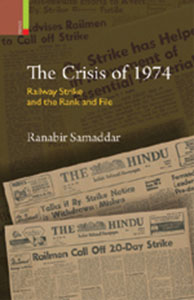
The Crisis of 1974: Railway Strike and the Rank and File
AUTHOR- Ranabir Samaddar
| HB ₹850 . $49.95 . ₤39.95 |
||
INFORMATION
- AUTHOR : Ranabir Samaddar
- HB ISBN : 978-93-84082-96-3
- Year : 2016
- Extent : 198
- Discount available on checkout
- Usually dispatched within 3 to 5 working days.
The Crisis of 1974
| HB ₹ 850 . $ . ₤ |
PB ₹ . $ . ₤ |
|
| POD ₹ . $ . ₤ |
e-Book ₹ . $ . ₤ |
INFORMATION
- AUTHOR – Ranabir Samaddar
- ISBN – 978-93-84082-96-3
- Year – 2017
- Extent: 400 + 40 coloured illustrations
- 10% discount + free shipping
- Usually dispatched within 3 to 5 working days.
This book on the Indian Railway Strike of 1974 looks at the history, the role of the rank and file in the strike, and the fate of the strike itself. Even as one of the most distinctive aspects of the strike was the autonomy of the rank and file, the significance of the struggle had much to do with the nature of the time. The country was in the midst of a general political crisis, sections of the peasantry were in revolt, and there were expressions of solidarity from the industrial working class. However, the strike leadership was not resolute and decisive, and failed the rank and file. In the absence of a political vanguard, the uprising was left without a determined subject.
The railwaymen did not transform India, but established for the first time in the political history of post-Independent India the autonomy of the political practice of masses. Suddenly, the strike had opened up a vision whose infinite nature unnerved both the party or order and the parties of constitutional opposition.
This book will interest all those interested in Labour History, and the history of the railway in the Indian subcontinent. The Railway Strike of 1974 was one of the most pervasive strikes in the history of the railway in India, and this carefully researched book will give the reader valuable insights into the causes, development, and trajectories of this seminal crisis in modern Indian history.
The Author
Ranabir Samaddar is currently the Distinguished Chair, Calcutta Research Group, and has worked extensively on issues of migration and forced migration, nationalism and post-colonial statehood in South Asia, and new regimes of technological restructuring, labour control, and forms of labour. His recent writings on post-colonial capitalism and India’s neoliberal development have signalled a new turn in critical post-colonial thinking. His co-authored work on new towns and new forms of accumulation, Beyond Kolkata: Rajarhat and the Dystopia of Urban Imagination (2013), takes forward urban studies in the context of post-colonial accumulation.
This book on the Indian Railway Strike of 1974 looks at the history, the role of the rank and file in the strike, and the fate of the strike itself. Even as one of the most distinctive aspects of the strike was the autonomy of the rank and file, the significance of the struggle had much to do with the nature of the time. The country was in the midst of a general political crisis, sections of the peasantry were in revolt, and there were expressions of solidarity from the industrial working class. However, the strike leadership was not resolute and decisive, and failed the rank and file. In the absence of a political vanguard, the uprising was left without a determined subject.
The railwaymen did not transform India, but established for the first time in the political history of post-Independent India the autonomy of the political practice of masses. Suddenly, the strike had opened up a vision whose infinite nature unnerved both the party or order and the parties of constitutional opposition.
This book will interest all those interested in Labour History, and the history of the railway in the Indian subcontinent. The Railway Strike of 1974 was one of the most pervasive strikes in the history of the railway in India, and this carefully researched book will give the reader valuable insights into the causes, development, and trajectories of this seminal crisis in modern Indian history.
The Author
Ranabir Samaddar is currently the Distinguished Chair, Calcutta Research Group, and has worked extensively on issues of migration and forced migration, nationalism and post-colonial statehood in South Asia, and new regimes of technological restructuring, labour control, and forms of labour. His recent writings on post-colonial capitalism and India’s neoliberal development have signalled a new turn in critical post-colonial thinking. His co-authored work on new towns and new forms of accumulation, Beyond Kolkata: Rajarhat and the Dystopia of Urban Imagination (2013), takes forward urban studies in the context of post-colonial accumulation.




